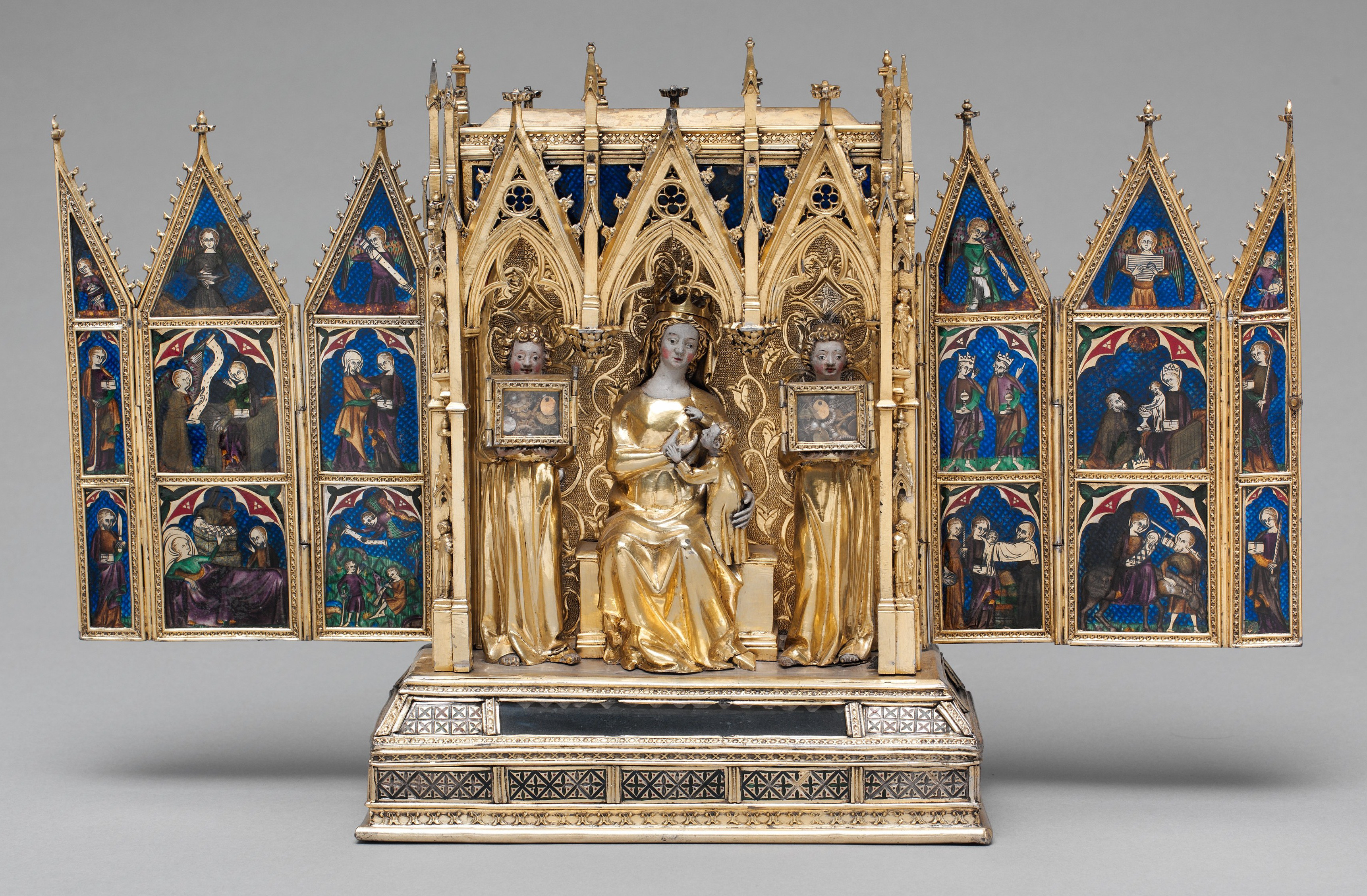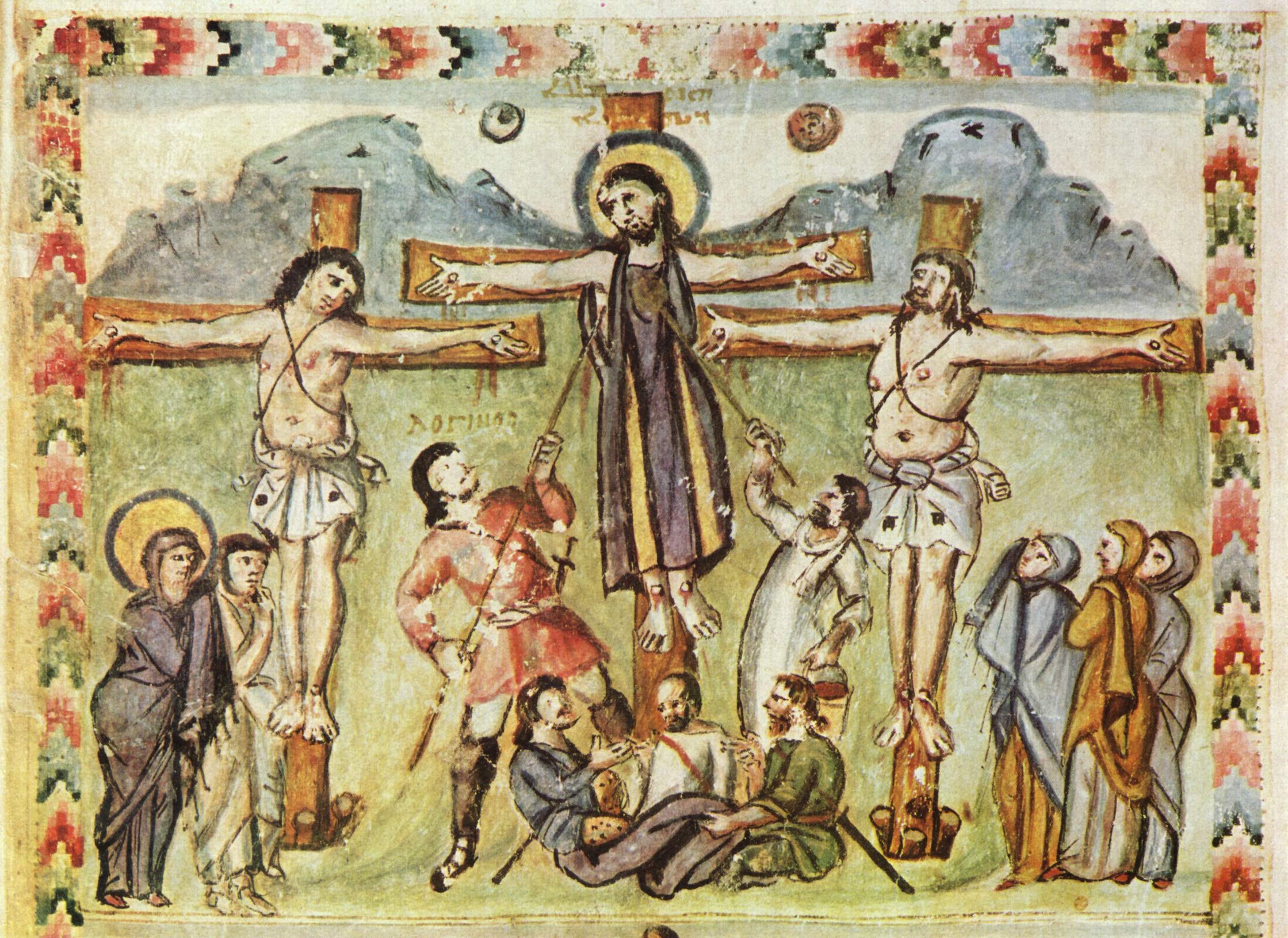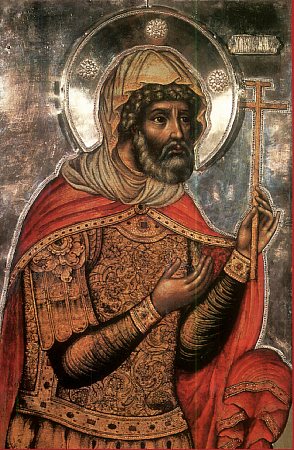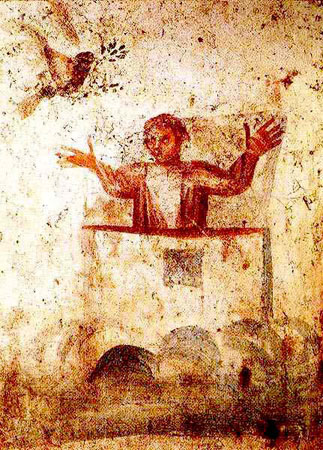|
Essen-Werden Casket
The Essen-Werden casket is a reliquary casket of in Essen-Werden. The casket is supposed to have originally served as a container for a small part of the True Cross, wood from the cross of Jesus, which St Liudger (742–809) had received from the Pope in Rome in 784. The casket is an oaken lidded box and measures 40 cm by 21.2 cm by 21.2 cm. Carved rectangular openwork panels on the casket are made of walrus ivory. The decorations on the casket have been assigned a wide range of dates between the 7th and 11th centuries, though scholarly opinion clusters around the late 7th and 8th centuries. These decorations were once nailed onto the casket in a disarray, as a result of makeshift repairs over the centuries which had been used to cover up damage to the decorations and to the box. The Essen-Werden casket undergone several successive reconstruction attempts. Wilhelm Effmann made the first attempt in 1901. He reconstructed a single crucifixion scene from the ivory pan ... [...More Info...] [...Related Items...] OR: [Wikipedia] [Google] [Baidu] |
Reliquary
A reliquary (also referred to as a ''shrine'', ''Chasse (casket), chasse'', or ''phylactery'') is a container for relics. A portable reliquary, or the room in which one is stored, may also be called a ''feretory''. Relics may be the purported or actual physical remains of saints, and may comprise bones, pieces of clothing, or some object associated with saints or with other religious figures. The authenticity of any given relic is often a matter of debate; for that reason, some churches require documentation of a relic's provenance. Relics have long been important to Buddhism, Buddhists, Christianity , Christians, Hinduism , Hindus, and to followers of many other religions. These cultures often display reliquaries in shrines, churches, or temples to which the faithful make pilgrimages to gain blessings. The term is sometimes used in a looser sense to mean a container for the remains of any important figure, even non-religious ones. In particular, the kings of France often spe ... [...More Info...] [...Related Items...] OR: [Wikipedia] [Google] [Baidu] |
Stephaton
Stephaton, or Steven, is the name given in medieval Christian traditions to the Roman soldier or bystander, unnamed in the Bible, who offered Jesus a sponge soaked in vinegar wine at the Crucifixion. In later depictions of the Crucifixion, Stephaton is frequently portrayed with Longinus, the soldier who pierced Jesus' side with a spear. It is not to be confused with a Xylospongium, a sponge that is soaked in vinegar attached to a stick the Romans used after defecating. Gospel accounts The account of Jesus receiving a sponge soaked in vinegar while on the cross appears in all four of the canonical gospels, with some variation. In both and , just after Jesus says "My God, my God, why have you forsaken me", a bystander soaks a sponge in vinegar and raises it on a reed for Jesus to drink. mentions that the attendant soldiers offer Jesus vinegar while mocking him – moving the mocking motif that occurs earlier in Mark and Matthew to the Crucifixion.Johnson, Luke Timothy, and Dani ... [...More Info...] [...Related Items...] OR: [Wikipedia] [Google] [Baidu] |
8th-century Artifacts
The 8th century is the period from 701 (represented by the Roman numerals DCCI) through 800 (DCCC) in accordance with the Julian Calendar. In the historiography of Europe the phrase the long 8th century is sometimes used to refer to the period of circa AD 660–820. The coast of North Africa and the Iberian Peninsula quickly came under Islamic Arab domination. The westward expansion of the Umayyad Empire was famously halted at the siege of Constantinople by the Byzantine Empire and the Battle of Tours by the Franks. The tide of Arab conquest came to an end in the middle of the 8th century.Roberts, J., '' History of the World'', Penguin, 1994. In Europe, late in the century, the Vikings, seafaring peoples from Scandinavia, begin raiding the coasts of Europe and the Mediterranean, and go on to found several important kingdoms. In Asia, the Pala Empire is founded in Bengal. The Tang dynasty reaches its pinnacle under Chinese Emperor Xuanzong. The Nara period begins in Jap ... [...More Info...] [...Related Items...] OR: [Wikipedia] [Google] [Baidu] |
7th-century Artifacts
The 7th century is the period from 601 through 700 in accordance with the Julian calendar in the Christian Era. The spread of Islam and the Muslim conquests began with the unification of Arabia by the Islamic prophet Muhammad starting in 622. After Muhammad's death in 632, Islam expanded beyond the Arabian Peninsula under the Rashidun Caliphate (632–661) and the Umayyad Caliphate (661–750). The Muslim conquest of Persia in the 7th century led to the downfall of the Sasanian Empire. Also conquered during the 7th century were Muslim conquest of Syria, Syria, Palestine (region), Palestine, Muslim conquest of Armenia, Armenia, Muslim conquest of Egypt, Egypt, and Muslim conquest of the Maghreb, North Africa. The Byzantine Empire suffered setbacks during the rapid expansion of the Caliphate and a mass incursion of Slavs in the Balkans which reduced its territorial limits. The decisive victory at the Siege of Constantinople (674–678), Siege of Constantinople in the 670s led t ... [...More Info...] [...Related Items...] OR: [Wikipedia] [Google] [Baidu] |
Ennabeuren Reliquary
The Ennabeuren reliquary is a Christian reliquary found buried under the altar of a parish church in , Alb-Donau-Kreis. The reliquary dates from the mid-7th century to the early 8th century. The reliquary is made out of limewood and covered in gilded copper. German archeologist Dieter Quast has written a monograph on the reliquary arguing for pagan influences on its design. Gallery See also * Essen-Werden casket The Essen-Werden casket is a reliquary casket of in Essen-Werden. The casket is supposed to have originally served as a container for a small part of the True Cross, wood from the cross of Jesus, which St Liudger (742–809) had received from the ... References Further reading * Gannon, A. "The Ennabeuren Reliquary Casket: Reckoning on Redemption" in Newman, C.; Mannion, M.; and Gavin, F. (eds.) ''Islands in a Global Context: Proceedings of the Seventh International Conference on Insular Art''. Dublin: Four Courts Press (2017), pp. 65–74. * Quast, D. ''Das merowin ... [...More Info...] [...Related Items...] OR: [Wikipedia] [Google] [Baidu] |
Brescia Casket
The Brescia Casket, also called the lipsanotheca of Brescia (in Italian ''lipsanoteca'') or reliquary of Brescia, is an ivory box, perhaps a reliquary, from the late 4th century, which is now in the Museo di Santa Giulia at San Salvatore, Brescia, San Salvatore in Brescia, Italy. It is a virtually unique survival of a complete Early Christianity, Early Christian ivory box in generally good condition. The 36 subjects depicted on the box represent a wide range of the images found in the Early Christian art, evolving Christian art of the period, and their identification has generated a great deal of art-historical discussion, though the high quality of the carving has never been in question. According to one scholar: "despite an abundance of resourceful and often astute exegesis, its date, use, provenance, and meaning remain among the most formidable and enduring enigmas in the study of early Christian art." The complex iconography of the five faces is illustrated and identified ... [...More Info...] [...Related Items...] OR: [Wikipedia] [Google] [Baidu] |
Hildesheim Reliquary Of Mary
The Hildesheim Reliquary of Mary (German: ''Heiligtum Unserer Lieben Frau''; ''Lipsanothek'') is a historic and artistically unique reliquary in the Dommuseum in Hildesheim. It dates back to the early period of the diocese and is associated with the legend of the founding of the Cathedral. History Tradition and legend claims that in 815 Emperor Louis the Pious had a reliquary that he and his hunting party lost in the woods and upon finding it were unable to free from a rosebush. The Emperor took this as a sign that the Cathedral and diocese were meant to be established at that location (Hildesheim) and dedicated to Mary. Thus, to this day, the reliquary embodies the historical identity and continuity of the diocese. At the ordination of enthronement of a new bishop of Hildesheim, it is presented to them as a special symbol of their solemn reception of the diocese from their predecessor or the Diocesan administrator. The silver relic-box is the oldest part of the item. It is ... [...More Info...] [...Related Items...] OR: [Wikipedia] [Google] [Baidu] |
Greek Cross
The Christian cross, with or without a figure of Jesus, Christ included, is the main religious symbol of Christianity. A cross with a figure of Christ affixed to it is termed a crucifix and the figure is often referred to as the ''corpus'' (Latin for "body"). The term ''Greek cross'' designates a cross with arms of equal length, as in a plus sign, while the Latin cross designates a cross with an elongated descending arm. Numerous other variants have been developed during the Middle Ages, medieval period. Christian crosses are used widely in churches, on top of church buildings, on bibles, in heraldry, in personal jewelry, on hilltops, and elsewhere as an attestation or other symbol of Christianity. Crosses are a prominent feature of Christian Cemetery, cemeteries, either carved on Headstone, gravestones or as sculpted Stele, stelae. Because of this, planting small crosses is sometimes used in countries of Christian culture to mark the site of fatal accidents, or, such as the Z ... [...More Info...] [...Related Items...] OR: [Wikipedia] [Google] [Baidu] |
Longinus
Longinus (Greek: Λογγίνος) is the name of the Roman soldier who pierced the side of Jesus with a lance, who in apostolic and some modern Christian traditions is described as a convert to Christianity. His name first appeared in the apocryphal Gospel of Nicodemus. The lance is called in Catholic Christianity the "Holy Lance" ('' lancea'') and the story is related in the Gospel of John during the Crucifixion. This act is said to have created the last of the Five Holy Wounds of Christ. This person, unnamed in the Gospels, is further identified in some versions of the story as the centurion present at the Crucifixion, who said that Jesus was the son of God, so he is considered as one of the first Christians and Roman converts. Longinus's legend grew over the years to the point that he was said to have converted to Christianity after the Crucifixion, and he is traditionally venerated as a saint in the Roman Catholic Church, Eastern Orthodox Church, and several other Christi ... [...More Info...] [...Related Items...] OR: [Wikipedia] [Google] [Baidu] |
Orans
Orans, a loanword from Medieval Latin ''orans'' () translated as "one who is praying or pleading", also orant or orante, as well as lifting up holy hands, is a posture or attitude (art), bodily attitude of prayer, usually standing, with the elbows close to the sides of the body and with the hands outstretched sideways, palms up. The orans posture of prayer has a Scriptural basis in 1 Timothy 2 (): "I desire, then, that in every place the men should pray, lifting up holy hands without anger or argument" (NRSV). It was common in early Christianity and can frequently be seen in early Christian art, being advised by several early Church Fathers, who saw it as "the outline of the cross". In modern times, the orans position is still preserved in Oriental Orthodoxy, as when Coptic Christian believers pray the seven canonical hours of the Agpeya at fixed prayer times. The orans also occurs within parts of the Catholic, Oriental Orthodox, Eastern Orthodox Church, Eastern Orthodox, Luther ... [...More Info...] [...Related Items...] OR: [Wikipedia] [Google] [Baidu] |
Essen-Werden
Werden ( Westphalian: ''Wadden'') is a southern borough of the city of Essen in Germany. It belongs to the city district ''IX Werden/Kettwig/Bredeney'' and has 9,998 inhabitants as of June 30, 2006. The borough occupies a space of and is situated at a median height of . The town is home to thEssen-Werden CampusoFolkwang University of the Arts The Benedictine abbey in central Werden houses Folkwang’Orchestral Performanceconservatory. Thjazz buildingis at Wesselswerth 23, and the White Mill (Weisse Mühle) at Hardenbergufer 59 houses Musical Theater courses. __TOC__ History The history of Werden can be traced back to St. Ludger, who founded Werden Abbey at the end of the 8th century. His stone coffin is preserved in the crypt. In 1317, Werden was granted city rights. The Abbey buildings have housed the Folkwang Hochschule since 1927. in Werden houses the 7th-century Essen-Werden casket. The ("Silver Bible"), traditionally ascribed to bishop Ulfilas, was discovered in ... [...More Info...] [...Related Items...] OR: [Wikipedia] [Google] [Baidu] |
Mainz
Mainz (; #Names and etymology, see below) is the capital and largest city of the German state of Rhineland-Palatinate, and with around 223,000 inhabitants, it is List of cities in Germany by population, Germany's 35th-largest city. It lies in the Frankfurt Rhine-Main, Rhine-Main Metropolitan Region—Germany's second-largest metropolitan region after Rhine-Ruhr—which also encompasses the cities of Frankfurt am Main, Wiesbaden, Darmstadt, Offenbach am Main, and Hanau. Mainz is located at the northern end of the Upper Rhine Plain, on the left bank of the Rhine. It is the largest city of Rhenish Hesse, a region of Rhineland-Palatinate that was historically part of Grand Duchy of Hesse, Hesse, and is Rheinhessen (wine region), one of Germany's most important wine regions because of its mild climate. Mainz is connected to Frankfurt am Main by the Rhine-Main S-Bahn rapid transit system. Before 1945, Mainz had six boroughs on the other side of the Rhine (see: :de:Rechtsrheinische St ... [...More Info...] [...Related Items...] OR: [Wikipedia] [Google] [Baidu] |








